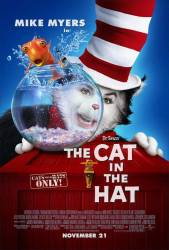Plot hole: In the scene at the little girl's party where Cat is the pinata, and he gets whacked in the groin, he screams out loud, all the kids hear him, you even see their shocked faces as well. But after Conrad and Sally throw the lollies, the kids totally forget about Cat yelling - hardly likely given the level of shock. As well as that, wouldn't the kids have noticed that the Cat didn't have a hole in it when they saw the lollies? They just came from behind a bush. And to top it all off, in the scene where all the kids are greedily on the ground grabbing the lollies, and the Cat's about to hit the kid that whacked him, in the bottom left corner, a little girl looks directly at the Cat, Conrad and Sally.
Plot hole: When Conrad, Sally and the Cat pull up to the house the camera cuts after they stop. The Cat is suddenly missing, and as the kids go up on the porch, Lawrence pops up from beside the porch. First, how did he beat them there, when he was a couple of minutes behind? Second, when the kids were approaching the house, how did they not see Lawrence crouching beside the porch when he would have been in plain sight from the direction of the driveway?






Chosen answer: Theodor Seuss Geisel, or Dr. Suess as we know him, published most of his books between the late 1930's and the late 1980's. "The Cat in the Hat" was first published in 1957. Dr. Seuss' works generally tell the stories of fantastical characters in imaginary places, meant to be timeless. Illustrations and animated adaptations show buildings and objects with unusual proportions, odd shapes and bizarre functions. The live action film of "The Cat in the Hat, " however, is rooted to reality by its decidedly human child protagonists in an ordinary house in an ordinary neighborhood. The production design, costume design and set decoration of the 2003 film seem also to have the goal of achieving a certain timelessness. No date reference is given. However, there a decidedly stylized quality of 1950's-1960's suburban architecture and design, complete with its generic forms, chimneys, picket fences, and colors such as yellows and avocado greens, reflecting the common decor of the time. Similar to the 1971 TV short, which seems to provide a reference point for the design aesthetic of the film, nothing appears exceedingly futuristic nor rooted in period styles like victorian or colonial. I have also posed your question to Rita Ryack, the film's costume designer, whom I found on Facebook. If she sees my questions and decides to respond, I will add her insights to this answer.